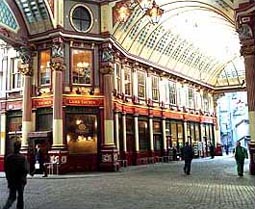
A traditional English Christmas dinner consists of roast turkey and stuffing, roast potatoes and vegetables, bread sauce, cranberry sauce and gravy, followed by Christmas pudding with brandy butter.
In the PastIn Medieval England the rich and famous dined on peacocks and swans at Christmas but boar's head was the main course. The unfortunate peasants had to make do with whatever they could find.
In the 18th century, boar's head become unfashionable and goose was preferred. By Victorian times, the turkey had become the nations favourite for the Christmas meal.
THE CHRISTMAS GOOSE RUN
There are many traditions associated with Christmas but
none is more popular than the annual Christmas meal. Each year millions
of families gather round the dinner table to enjoy a Christmas turkey
with all the trimmings. But turkey has not always been the nation’s
favourite and in times gone by Goose was a very popular alternative.
Many families saved their pennies throughout the year to be able to buy
a fine goose for their Christmas meal. The rush to market for this annual
feast was a major event for many East Anglian poultry farmers and towns
like Sudbury and Clare were on the route to the London markets of Leadenhall
and Smithsfield. The Focus investigates the history of the annual goose
run and the legends it has produced.
Christmas is coming, the goose is getting fat. Please put
a penny in the old man's hat...
-Traditional, English
Geese on their way to London passing through Clare.
In 1722 Daniel Defoe remarked in his book ‘Tour through
the Eastern Counties of England’: “The county of Suffolk is
particularly famous for the number of Turkey and Geese that are marched
to market in London ready for the annual Christmas sales”.
He went on to say “I received an account from a person living on
the place that they have counted 300 droves of birds (for they drive them
all in droves on foot) and pass in one season over Stratford Bridge on
the River Stour”. These droves, as they say, generally contain from
three hundred to a thousand each: so that one may suppose them to contain
five hundred one with another which is one hundred and fifty thousand
in all.
It was common practice to protect the birds feet by dipping them in tar and covering them with sand for their 100-mile trek which was completed at a brisk waddling pace of about 1 mile an hour. The epic nature of this goose run has become the stuff of legends and in 1984 a film called ‘Singleton’s Pluck’ commemorated this remarkable journey by following a Norfolk farmer (Singleton, played by Ian Holm, who also played Bilbo in The Lord of The Rings) who was forced to take his geese to market in the traditional manner following a strike by truck drivers.
The film faithfully followed one of the old goose runs and the hero came through Western Suffolk with a gaggle of geese as noisy extras. Our photograph shows the geese passing through Clare market square headed by the actor Bill Owen (famous for his Compo character in Last of the Summer Wine) who was one of Singleton’s farm hands.
Some 200 years ago this would have been a common sight as the Christmas season approached.
The London drive was a modest affair compared with the epic performed by the domestic geese of ancient France, where the Gauls used to march them over the alps to the markets in Roman Italy.



Leadenhall
A meat and fish market occupied a series of courts behind
the grand lead-roofed mansion of Leadenhall on Leadenhall street in the
14th century. It was an established meeting place of the Poulterers as
early as 1321
The market was used for the sale of fish, meat, poultry and corn, although
in 1666 portions of the market were destroyed by the Great Fire. A celebrated
character in Leadenhall during the 18th century was 'Old Tom', a gander
who managed to escape execution even though it is recorded that 34,000
geese were slaughtered there in two days. He became a great favourite
in the market and was fed at the local inns. After his death in 1835 at
the age of 38, he lay in state in the market and was buried there.